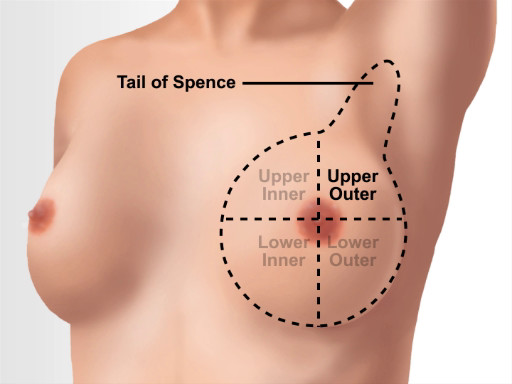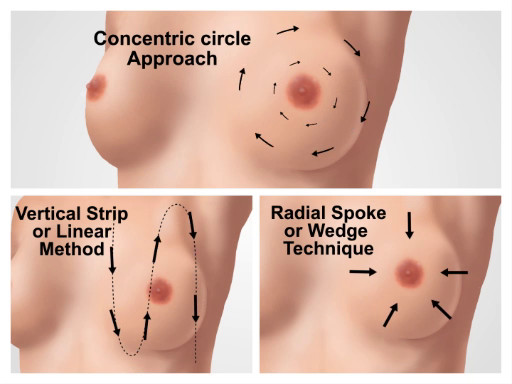Umfassende Brustuntersuchung
Überblick
Quelle:
Alexandra Duncan, GTA, Praxis Klinik, New Haven, CT
Tiffany Cook, GTA, Praxis Klinik, New Haven, CT
Jaideep S. Talwalkar, MD, Innere Medizin und Pädiatrie, Yale School of Medicine, New Haven, CT
Brust Prüfungen sind ein wesentlicher Bestandteil der eine jährliche gynäkologische Untersuchung und sind wichtig für alle Patienten, unabhängig von ihrem Geschlecht oder Geschlecht Ausdruck. Eine von 8 Frauen wird Brustkrebs diagnostiziert werden; Brustkrebs beim Mann, aber hat weniger häufig, eine lebenslange Inzidenz von 1: 1000.
Prüfungen Brust spürt invasive Patienten, daher es wichtig ist, alles daranzusetzen, die Patienten fühlen sich wohl und ermächtigt, anstatt anfällig machen. Prüfer sollten sich bewusst was sie kommunizieren, verbal und nonverbal, und geben ihren Patienten Kontrolle, wo immer möglich sein (zum Beispiel immer es ihnen ermöglicht, ihre eigenen Kleider zu entfernen). Prüfer können Chaperone nutzen für der Patienten (sowie ihre eigenen) Komfort. Einige Institutionen erfordern den Einsatz von Chaperonen.
Während es immer wichtig, übermäßig klinischen Sprache zu vermeiden, können bestimmte umgangssprachliche Wörter die Linie überqueren, von der Pflege zu allzu intime in dieser Prüfung. Es ist hilfreich, die Worte "Touch" und "fühlen" in dieser Prüfung zu vermeiden, da diese Sprache sexualisierte fühlen kann. Verwenden Sie Wörter wie "bewerten", "check", oder "prüfen."
Darüber hinaus bestimmt die beste Praxis Vermeidung von Annahmen über Patientenrechte Geschlecht, wie Patienten mit weiblichen Anatomie als ein anderes Geschlecht (z.B. Transgender, Genderqueer) identifizieren können. Dieses Video zeigt die Annäherung an Patienten, deren Geschichte offenbart hat, keine konkreten Beschwerden oder Risikofaktoren im Zusammenhang mit der Gesundheit der Brust.
Zur Vermeidung von möglichen Ergebnisse fehlen die Brustuntersuchung sollten in einem systematischen Ansatz durchgeführt werden und besteht aus drei Hauptkomponenten: Sichtprüfung des Brustgewebes, Abtasten der Lymphknoten und Palpation des Brustgewebes.
Das Brustgewebe reicht von direkt unter das Schlüsselbein, um den fünften Rippe (oder BH-Linie). Seitlich, es erstreckt sich von der midaxillary Linie auf der sternalen Grenze. Die Brust wird in vier Quadranten angesehen; die obere äußeren Quadranten hat die meisten Gewebe befindet sich viele Lymphknoten und der Schweif von Spence (oder axillären Tail) erstreckt sich an den Rand von der Achselhöhle, wo legt es auf die Brustwand (Abbildung 1).

Abbildung 1. Brust anatomischen Landmarken.
Verfahren
1. Vorbereitung
- Schaffen Sie vor Beginn der Prüfungen Brust eine Erwartung an Komfort zu und bitten Sie den Patienten, Fragen und Anliegen während des Besuchs zu kommunizieren. Zum Beispiel etwas sagen wie, "Sie hatten eine Prüfung vor? Wie war diese Erfahrung für Sie? Ich erwarte, dass dies eine komfortable Prüfung sein. Wenn es etwas, was ich tun kann, um dies für Sie komfortabler zu gestalten, lass es mich wissen und ich werde keine Anpassungen kann ich machen. Sie können mich jederzeit Fragen."
Anwendung und Zusammenfassung
Dieses Video umfasst wie die klinische Brustuntersuchung durchführen und überprüfen und Brustgewebe und die zugehörigen Lymphknoten zu untersuchen. Bevor die Brustuntersuchung gestartet wird, sollte der Prüfer die Erwartung, dass der Patient während des Besuchs Fragen und Anliegen kommunizieren kann. Der Patient sollten aufgefordert werden, das Kleid nur bei Bedarf entfernen und daran erinnert, wann man das Kleid während der Prüfung zu erhöhen. Dies minimiert die Gefühle der Verwundbarkeit.
Log in or to access full content. Learn more about your institution’s access to JoVE content here
pringen zu...
Videos aus dieser Sammlung:

Now Playing
Umfassende Brustuntersuchung
Physical Examinations II
86.8K Ansichten

Augenuntersuchung
Physical Examinations II
76.6K Ansichten

Ophthalmoskopie
Physical Examinations II
67.3K Ansichten

Untersuchung der Ohren
Physical Examinations II
54.5K Ansichten

Untersuchung der Nase, Nebenhöhlen, Mundhöhle und Rachen
Physical Examinations II
65.2K Ansichten

Untersuchung der Schilddrüse
Physical Examinations II
104.3K Ansichten

Überprüfung der Lymphknoten
Physical Examinations II
385.1K Ansichten

Abdominaluntersuchung I: Inspektion und Auskultation
Physical Examinations II
202.1K Ansichten

Abdominaluntersuchung III: Palpation
Physical Examinations II
247.4K Ansichten

Abdominal-Prüfung III: Palpation
Physical Examinations II
138.3K Ansichten

Abdominaluntersuchung IV: Beurteilung akuter abdominaler Schmerzen
Physical Examinations II
67.1K Ansichten

Männliche Rektaluntersuchung
Physical Examinations II
113.8K Ansichten

Gynäkologische Untersuchung I: Beurteilung der äußeren Genitalien
Physical Examinations II
304.3K Ansichten

Gynäkologische Untersuchung II: Spekulumuntersuchung
Physical Examinations II
149.6K Ansichten

Gynäkologische Untersuchung III: Bimanuelle und rektovaginale Untersuchung
Physical Examinations II
146.9K Ansichten
Copyright © 2025 MyJoVE Corporation. Alle Rechte vorbehalten

